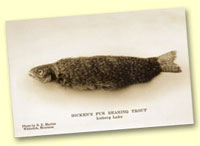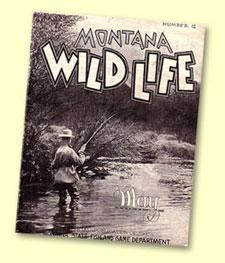 |
|
A
rare, nearly extinct breed, the Hicken's Furbearing Trout is from
the Artikdannder genus of fish and is found in the arctic lakes north
of the 72nd parallel. Its diet consists primarily of ice-worms and
fod. Sometimes confused with the more common Alpino-Pelted Trout.
Source: Petrie
Encyclopedia of Zoology,
Vol. 7, (1938)
|
|
|
 |
May,
1929 - Montana WildLife
Official Publication of the Montana State
Fish and Game Department Eastern
dudes beset with the opinion that everything west of Buffalo is outside
the United States, that the Mississippi valley is way out west, that
most every feller in Montana and sister states goes out and kills
himself an Indian before breakfast just to keep in shape, have become
interested in the fur-bearing fish discovered and copyrighted by
J.H. Hicken of Whitefish Montana. Mr. Hicken has kindly granted Montana
Wildlife permission to publish the photograph and story of this mysterious
piscatorial curiosity. Here’s the way he tells it, believe
it or not.
|
|
|
|
|
 |
The
discovery of this fur-bearing fish was made while traveling through
Glacier National Park during a sudden drop in temperature, following
up of which led to “Iceberg
Lake” located near Whitefish,
Montana. Several hooks were broken immediately upon touching
the water. Finally one was heated, and when it hit the water,
the temperature tempered
the hook, with the result that one of the fish was caught. “The
water in this lake is so cold that nature has taken care of her
own by providing the fish with a thick coat of fur. In fact the
water is so
cold that it is beyond the freezing point.”
The bezel, a very rare specimen, is found only on Prince Edward Island
and lives on the hum of the humming bird. They were found
to be the only bait that these fish will bite except in extreme warm weather,
when it
has been earned that they will bite on ice worms. Another
peculiarity of this fish is that it follows the precept of the poet who said: “in
the spring a young man’s fancy lightly turns to thoughts
of love. So, with these fish, and during this period with
a portable phonograph,
by putting on a love song the fish will come to the surface
and the quick
transfer, to a jazz record results in them shaking themselves
to death, when they can be picked out of the water.
It has been found that these fish absolutely refuse to bite during
the “love” month
of June, but as there is always a black sheep in every
family, the one caught (picture of which has been taken) disgraced
himself
before the
entire family and suffered the usual penalty.
|
|
They
make a rare fight in landing them out of the water, due to the
fact that nature has provided them with this fur, which ruffles and
causes
such a resistance that it is practically impossible to land them
only under most favorable circumstances. The fur also acts as an
accelerator, and when they step on the gas with their tails and
fins their speed is beyond any known fish at the present time. This,
in
turn, also acts as a brake in reducing speed or stopping, by simply
putting the fur against the grain, and is their protection against
survival of the fittest.
The change of temperature from this water to atmosphere is so great that
the fish explodes upon being taken from the water, and fur and skin come
off in one perfect piece, making it available for tanning and commercial purposes,
and leaving the body of the fish for refrigerator purposes or eating, as
desired;
the body keeping the ordinary refrigerator cold for two or three months and
no ice required. If fish is desired for eating purposes it will take several
days’ cooking
to reduce the temperature to a point where ordinary people can dispose of
it
If the fur is made into a neckpiece it has been found to be a cure for goiter
and tonsillitis; the fur stimulating circulation to such an extent that all
impurities are removed. The fish has been so recently discovered that information
regarding
their habits, etc., is very meager, but further details will be given when
available.
James
Herbert Hicken – A railroad man who left to
live with the black-foot Indians around Whitefish Montana
|
|
|



